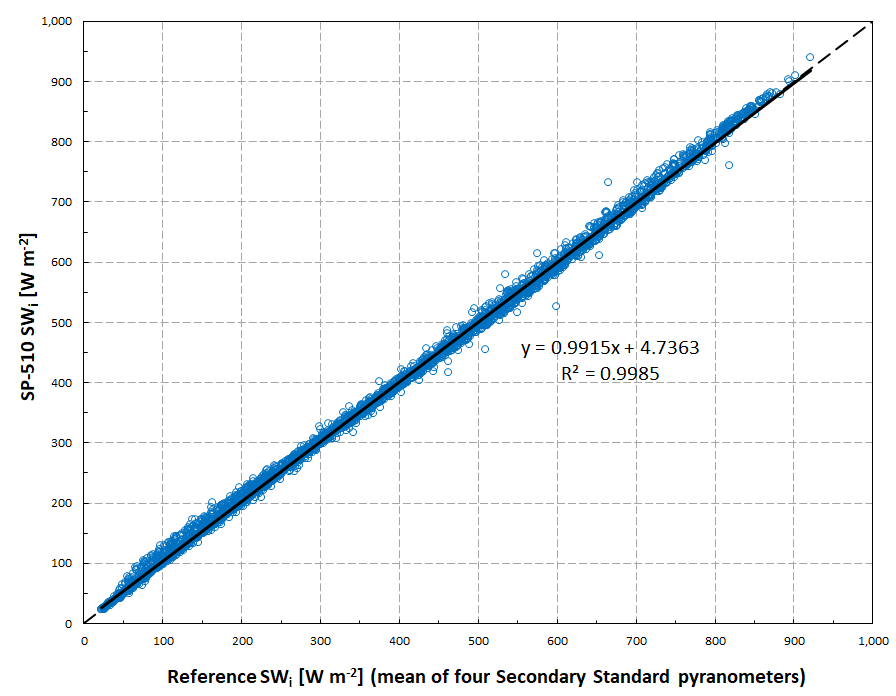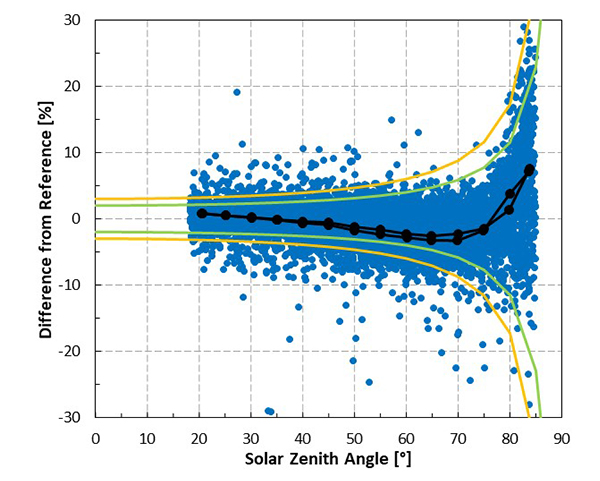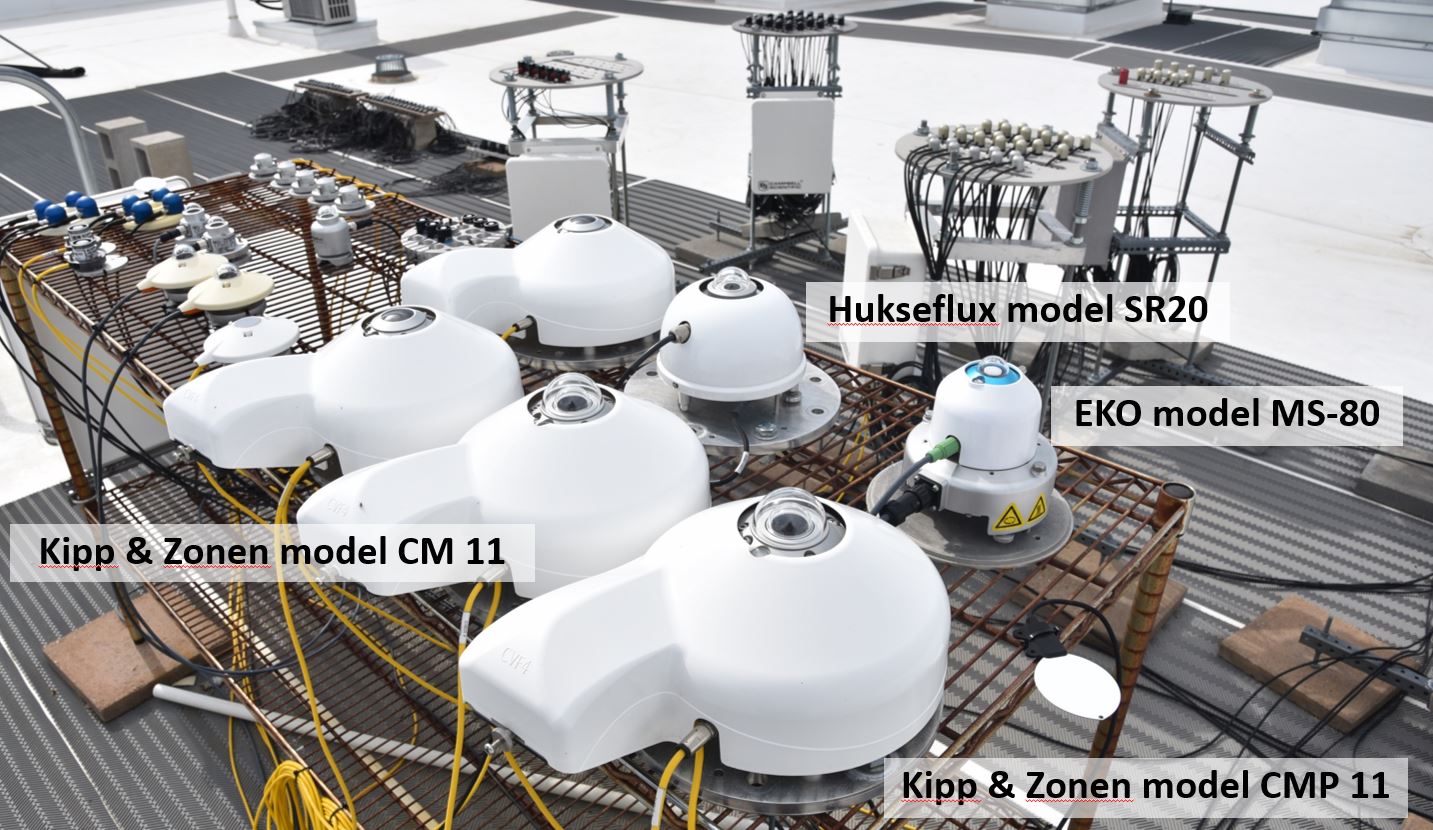Apogee Thermopile Pyranometers vs. Class A (Secondary Standard) Models

QUICK LINKS
- Specifications & Features
- Thermal Offset
- Long-term Stability
- Directional Response
- Temperature Response
- Measurements Under Variable Sky Conditions
- Summary
INTRODUCTION
There are multiple pyranometer options available for global horizontal and plane of array shortwave irradiance measurements. Some solar power installations require ISO Class A (formerly known as "secondary standard") pyranometers, but those that don’t may use Class B or Class C pyranometer (formerly known as first or second class), or a silicon-cell pyranometer. The advantage of silicon-cell pyranometers is low cost, but they are not sensitive to all solar wavelengths. Silicon is only sensitive from 350 to 1100 nm, thus, silicon-cell pyranometers sub-sample the solar spectrum. This results in spectral errors when the solar spectrum changes. The advantage of first and second class pyranometers is sensitivity to all solar wavelengths, minimizing spectral errors, but they are higher cost.
Here, performance of a new, compact and low-cost blackbody thermopile pyranometer, the Apogee model SP-510, is detailed. Specifications of the new pyranometer compare favorably to ISO second class and first-class blackbody thermopile pyranometers, but price is similar to silicon-cell pyranometers. The new pyranometer and silicon-cell pyranometers were compared to secondary standard pyranometers for two years in Logan, Utah. Performance of the new thermopile pyranometer suggests it is an accurate and cost-effective alternative for solar irradiance measurements in applications that don’t require a secondary standard.

One-to-one plot of solar radiation measured by Class A (secondary standard) versus Apogee thermopile pyranometers.
The International Standards Organization (ISO) and World Meteorological Organization (WMO) classify pyranometers according to a standard set of specifications. Specifications for the Apogee SP-510 pyranometer were compared to these specifications (below), and some of the specifications for the SP-510 were evaluated by direct comparison of global shortwave irradiance measurements from seven replicate SP-510 pyranometers to mean global shortwave irradiance calculated from measurements from four secondary standard pyranometers
Specifications of the Apogee SP-510 thermopile pyranometer compared to ISO-9060 specifications for Class A (secondary standard), Class B (first class), and Class C (second class) pyranometers. Some of these specifications for the SP-510 were evaluated with field data (references to the table or figure are listed next to the specification).
|
Class A (Secondary Standard) | Class B (First Class) | Class C (Second Class) | Apogee SP-510 (Class C) | |
|---|---|---|---|---|
| Response time (95 %) | < 10 s | < 20 s | < 30 s | 0.5 s |
| Zero Offset A Due to 200 W m-2 net thermal radiation (ventilated) | ± 7 W m-2 | ± 15 W m-2 | ± 30 W m-2 | 8 W m-2 (unheated) |
| Zero Offset B Response to 5 K hr-1 change in ambient temperature | ± 2 W m-2 | ± 4 W m-2 | ± 8 W m-2 | ± 5 W m-2 |
| Stability Change per year (percent full scale) | ± 0.8 % | ± 1.5 % | ± 3 % | ± 2 % |
| Linearity | ± 0.5 % | ± 1 % | ± 3 % | ± 1 % |
| Directional response (up to 90°) | ± 10 W m-2 | ± 20 W m-2 | ± 30 W m-2 | ± 20 W m-2 (up to 80°) |
| Deviation due to temperature change within an interval of 50 K | 2 % | 4 % | 8 % | 5 % (-15 to 45 C) |
| Tilt Response | 0.5 % | 2 % | 5 % | 1 % |
| Uncertainty, hourly totals (95 % confidence level) | 3 % | 8 % | 20 % | 8 % |
| Uncertainty, daily totals (95 % confidence level) | 2 % | 5 % | 10 % | 5 % |
| Spectral range | 300 ‐ 3000 nm | 300 ‐ 3000 nm | 300 ‐ 3000 nm | 385 ‐ 2105 nm |
| Resolution | 1 W m-2 | 5 W m-2 | 10 W m-2 | < 1 W m-2 |
Shortwave Irradiance Reference
Seven replicate Apogee SP-510 thermopile pyranometers were compared to the mean of four secondary standard pyranometers on the rooftop of the Apogee building in Logan, Utah for two years. The four secondary standard pyranometers have been calibrated at the National Renewable Energy Laboratory (NREL) within the past two years. Measurements were made every twenty seconds with a Campbell Scientific CR1000 datalogger and mean measurements were output every fifteen minutes.
Four secondary standard pyranometers mounted on the rooftop of the Apogee building in Logan, Utah. Mean global shortwave irradiance from these sensors was used as a reference. The SP-510 and SP-610 pyranometers are mounted on the stands behind the Class A (secondary standard) pyranometers.
Nighttime thermal offset was determined by calculating the mean shortwave irradiance from an SP-510 pyranometer with the heater turned off and an SP-510 pyranometer with the heater turned on. It was considered nighttime when mean shortwave irradiance calculated from the four secondary standard pyranometers was less than 0 W m-2 .
Nighttime thermal offset [W m-2] for an SP-510 thermopile pyranometer with the heater turned off and an SP-510 with the heater turned on.
| Heater Status | Nighttime Thermal Offset [W m-2]* |
|---|---|
| Off | -1.3 ± 2.5 |
| On | -7.4 ± 3.4 |
*Nighttime thermal offset is shortwave irradiance measured at night. Net longwave irradiance at night is variable and depends on atmospheric conditions (for example, humidity, cloudiness). Nighttime thermal offsets listed are mean values plus or minus two standard deviations around the means from seven months of fifteen minute data. Mean net longwave irradiance during the seven months was -56 ± 30 W m-2 (two standard deviations), with a range of -131 to 3 W m-2. Zero offset A is the thermal offset when the net longwave irradiance is -200 W m-2. Nighttime thermal offset and Zero offset A should be equal if the nighttime net longwave irradiance were -200 W m-2.
Long-term stability was determined by direct comparison of seven prototype SP-510 thermopile pyranometers to the mean of the four Class A (secondary standard) pyranometers on rooftop of the Apogee building. Drift was calculated as the relative change over a one year interval [% yr-1 ]. Drift was calculated for five consecutive years.
Largest measured drift [% yr-1] for a single year for seven SP-510 thermopile pyranometers.
| Replicate | Drift [% yr-1]* |
|---|---|
| 1 | -0.4 |
| 2 | 0.8 |
| 3 | 0.5 |
| 4 | 1.0 |
| 5 | -0.9 |
| 6 | -0.7 |
| 7 | 0.4 |
*Drift listed is the largest value from a single year out of five years for each pyranometer. Pyranometers were deployed on the rooftop of the Apogee building continuously for five years. Drift was calculated on an individual year basis because the reference pyranometers were periodically recalibrated (two of the four were calibrated each summer). Calibration changes of the reference pyranometers make drift calculation for the entire five year interval difficult.
Directional response was determined by direct comparison of an SP-510 thermopile pyranometer to the mean of the four Class A (secondary standard) pyranometers on rooftop of the Apogee building (Figure 3). All replicate SP-510 pyranometers performed similarly.

Differences [%] of an SP-510 thermopile from the mean of four Class A (secondary standard) (reference) pyranometers as a function of solar zenith angle. Black lines are bin averages for AM and PM. The green and orange lines are estimates of the specifications for Class B (first class) (± 20 W m-2) and Class C (second class) (± 30 W m-2) pyranometers, respectively, as a function of solar zenith angle.
Temperature response was determined by direct comparison of an SP-510 thermopile pyranometer to the mean of the four Class A (secondary standard) pyranometers on rooftop of the Apogee building (Figure 4). All replicate SP-510 pyranometers performed similarly.
Differences [%] of an SP-510 thermopile from the mean of four Class A (secondary standard) (reference) pyranometers as a function of air temperature. Black line is a bin average. The green and orange lines are estimates of the specifications for Class B (first class) (4 % over a 50 C interval) and Class C (second class) (8 % over a 50 C interval) pyranometers, respectively, as a function of air temperature.
Measurements Under Variable Sky Conditions
Shortwave irradiance measurements from an SP-510 and an SP-110 pyranometer were compared to the mean of the four Class A (secondary standard) pyranometers under variable sky conditions to provide an indication of spectral error.
Ten day (September 20-29, days of year 263-272) time series of global shortwave irradiance [W m-2] from the mean of four Class A (secondary standard) (reference) pyranometers, an SP-510 thermopile pyranometer, and an SP-110 silicon-cell pyranometer (top graph). Differences [%] from the Class A (secondary standard) (reference) daily total for each day are listed. The first five days in the time series were partly cloudy to cloudy (there was light rain in the morning on day 267, so pyranometers may have been wet) and the last five days were mostly sunny to sunny. Differences [%] of the SP-510 and SP-110 from the mean of four secondary standard (reference) pyranometers (bottom graph). While the errors shown for cloudy and overcast conditions were from an SP-110 silicon-cell pyranometer, they are common to all silicon-cell pyranometers.
Differences [%] of an SP-510 thermopile pyranometer and an SP-110 silicon-cell from the mean of the four Class A (secondary standard) (reference) pyranometers as a function of cloudiness. Black lines are bin averages. The variable SWi / SWic is the ratio of measured global shortwave irradiance [W m-2] to clear sky global shortwave irradiance [W m-2] calculated from a model, and serves as a cloudiness index. Values of SWi / SWic near one indicate clear sky and values near zero indicate overcast sky. The predicted error values listed on each graph were calculated from the spectral response for each sensor and a solar spectrum for overcast conditions, assuming the pyranometers were calibrated under clear sky conditions.
- Specifications for the SP-510 pyranometer compare favorably to ISO Class B (first class) and meet Class C (second class) specifications.
- Evaluation of SP-510 by direct comparison the mean of four Class A (secondary standard) pyranometers indicates the SP-510 performs similar to ISO Class B (first class) and matches Class C (second class) pyranometers.
- The SP-510 is a cost-effective option for shortwave irradiance measurement applications that do not require an ISO classified pyranometer.
- Silicon-cell pyranometers are also cost-effective options for shortwave irradiance measurements, but they sub-sample the shortwave spectrum, resulting in errors when the spectrum changes with cloudiness.




